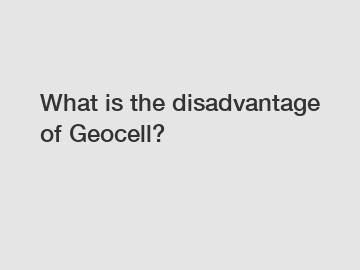What is the disadvantage of Geocell?
What is the disadvantage of Geocell?
Geocell technology has gained popularity in various construction and civil engineering projects due to its numerous advantages. Geocells, also known as cellular confinement systems, are three-dimensional grid-like structures made from high-density polyethylene (HDPE) materials. They are filled with different types of materials, such as soil, gravel, or concrete, to provide stability, reinforcement, and erosion control. While Geocell is generally advantageous, it also presents some disadvantages that need to be considered. In this article, we will explore the disadvantages of Geocell and discuss the potential drawbacks that practitioners should be aware of.
1. High Cost:

One of the significant disadvantages of Geocell technology is its relatively high cost compared to conventional construction methods. The materials used in Geocell production, particularly HDPE, can be expensive. Additionally, the installation process requires skilled labor and specialized equipment, increasing the overall project cost. Consequently, this cost factor may limit the widespread adoption of Geocell in certain construction projects.
2. Limited Compatibility:
Geocells may not be compatible with all soil types and environmental conditions. While they excel in cohesive soils, their effectiveness may be diminished in loose and granular soils. Likewise, Geocells may not perform optimally in extremely wet or saturated conditions, as water may enter the cells and compromise their structural integrity. Therefore, it is crucial to assess soil characteristics and environmental factors before considering Geocell installation.
3. Construction Expertise:
The successful implementation of Geocell technology relies heavily on the expertise of construction professionals. Proper design, installation, and monitoring are critical for achieving the desired outcome. In inexperienced hands, mistakes during installation may occur, leading to performance issues and potential project failures. To ensure the best results, it is essential to involve experienced geotechnical engineers who possess the necessary knowledge and skills in Geocell technology.
4. Maintenance Challenges:
Geocells require periodic inspections and maintenance to ensure their long-term performance. Over time, the cells may settle and shift due to external factors or traffic loads. If left unaddressed, these issues can compromise the stability and effectiveness of the Geocell system. Regular inspections and maintenance should be conducted to identify and address any potential problems promptly.
Conclusion:
Despite its numerous advantages, Geocell technology does come with some disadvantages that must be considered. The higher cost compared to conventional construction methods, limited compatibility with certain soil types and environmental conditions, the need for construction expertise, and regular maintenance requirements are among the key drawbacks. However, it is worth noting that these disadvantages do not negate the overall benefits of Geocell technology. When implemented correctly, Geocell can successfully improve soil stabilization, erosion control, and reinforcement, resulting in more sustainable and durable construction projects. By addressing the potential disadvantages and working with qualified professionals, the drawbacks can be effectively managed, allowing Geocell to continue playing a valuable role in the construction industry.
The company is the world’s best geocell supplier, hdpe smooth geomembrane manufacturers, ldpe smooth geomembrane supplier. We are your one-stop shop for all needs. Our staff are highly-specialized and will help you find the product you need.
200
0
0

Comments
All Comments (0)